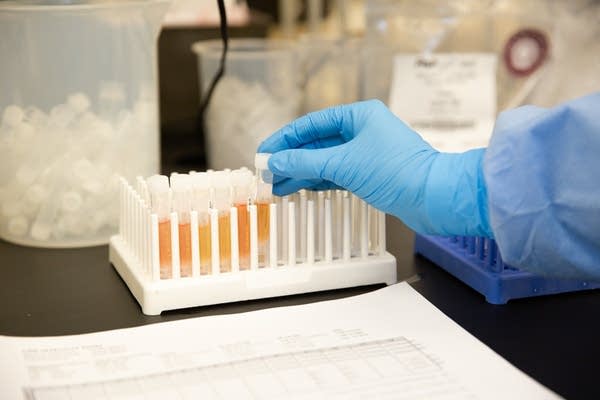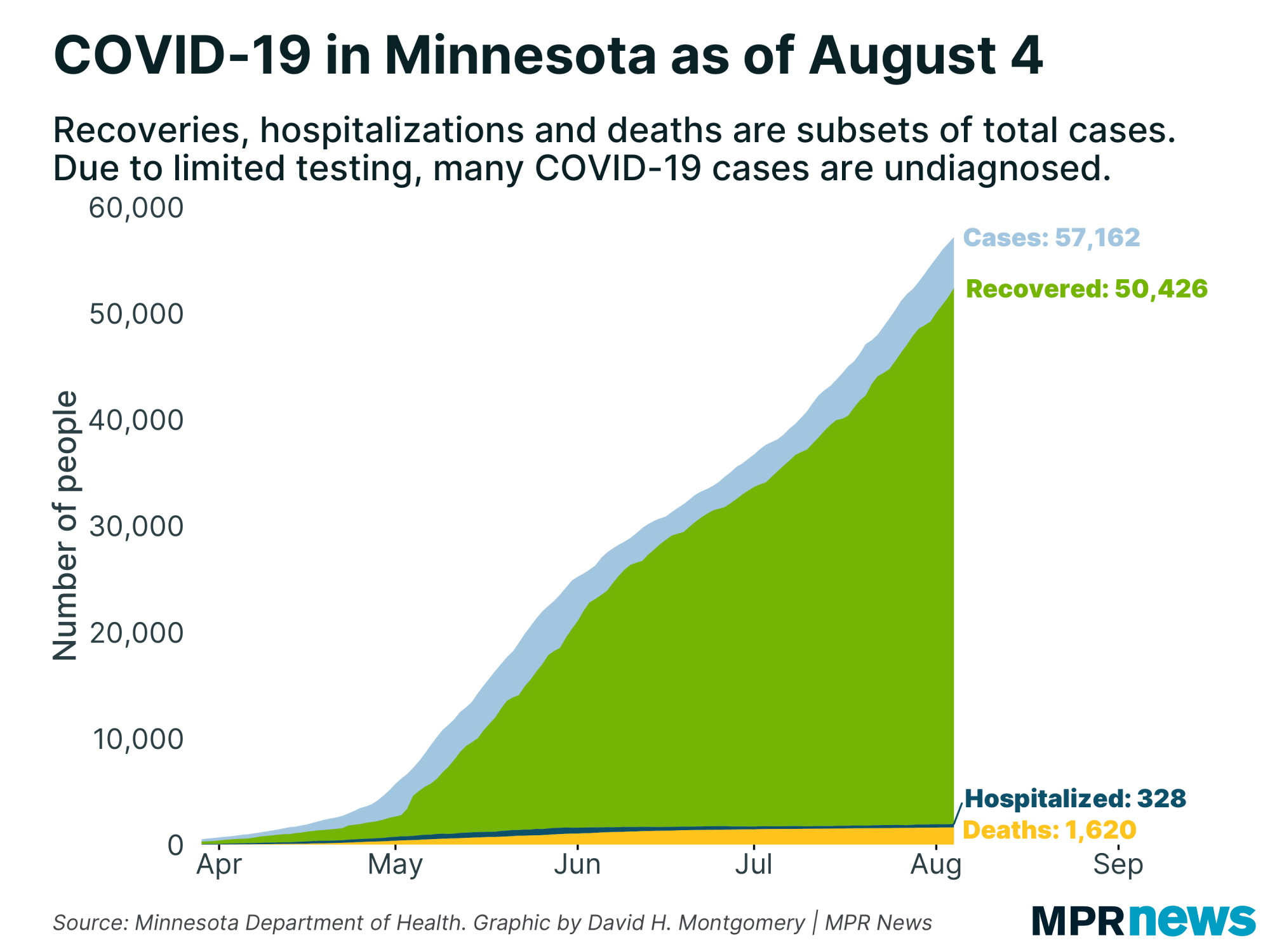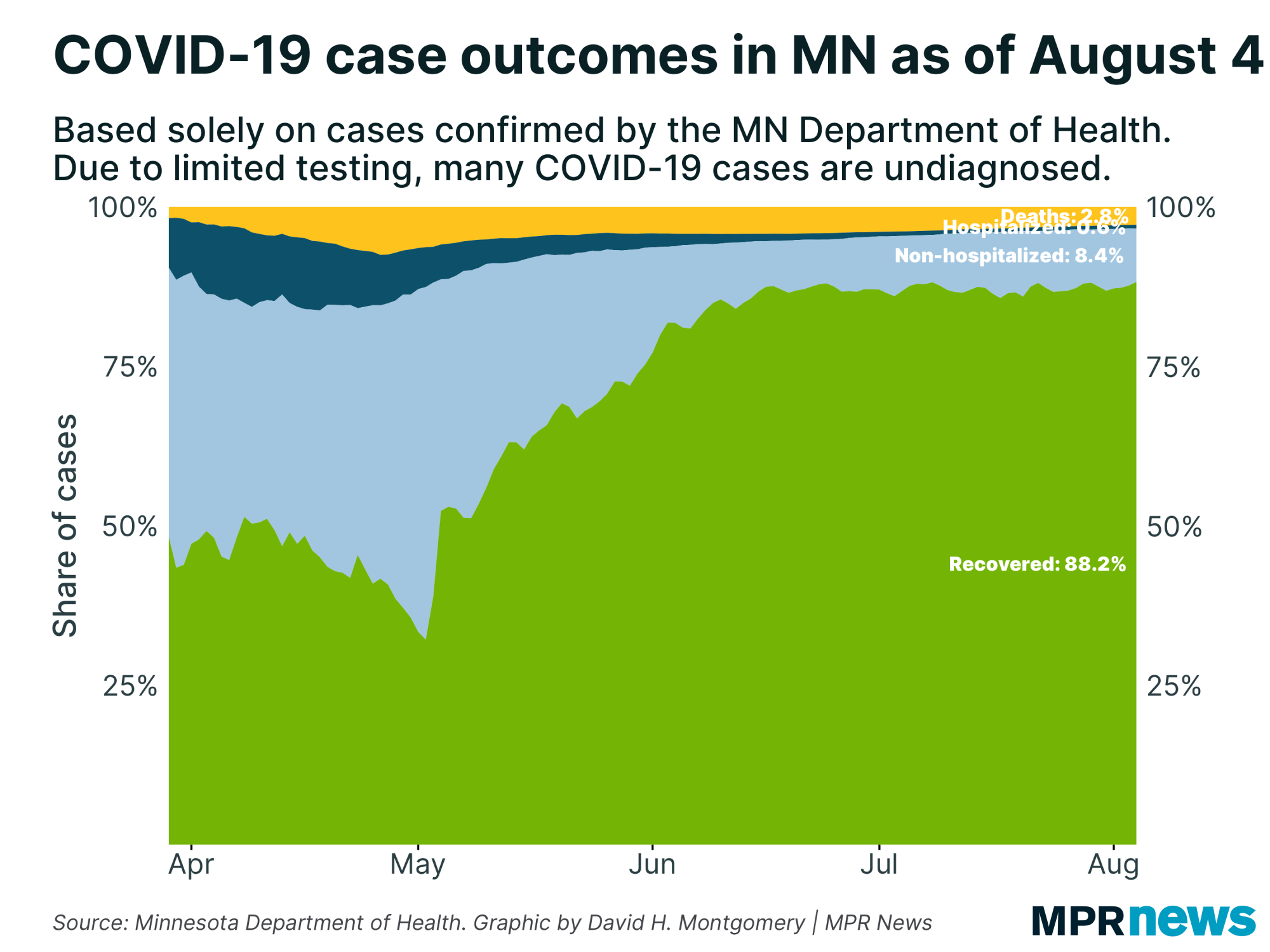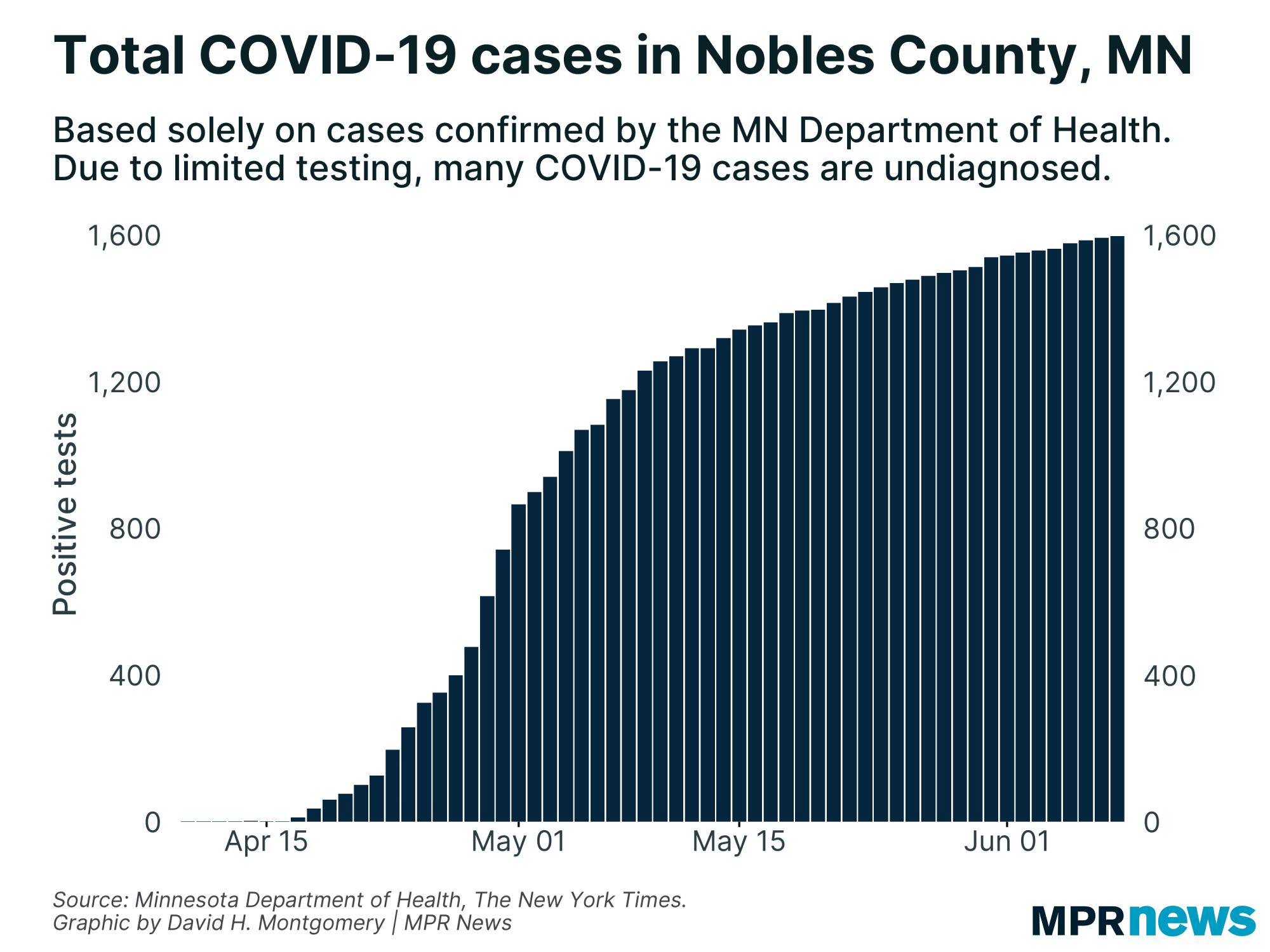April 25 update on COVID-19 in MN: Death toll in Minnesota increases to 244

Go Deeper.
Create an account or log in to save stories.
Like this?
Thanks for liking this story! We have added it to a list of your favorite stories.
Updated: 6:40 p.m.
The number of confirmed COVID-19 deaths in Minnesota climbed by 23 on Saturday — the largest single-day increase on record in the state since the pandemic began — as the number of confirmed cases also saw its largest daily jump.
The confirmed death toll in Minnesota is now 244, the state Department of Health reported. Officials said 22 of the 23 deaths reported Saturday were residents of long-term care facilities.
Meanwhile the overall confirmed number of cases increased by 261 to 3,446.
There’s been an upward trend in the number of test results reported each day, with more than 2,000 reported on Thursday (2,204), Friday (2,239) and Saturday (2,810). That compares to daily totals around 1,300 to 1,400 a week ago.
Turn Up Your Support
MPR News helps you turn down the noise and build shared understanding. Turn up your support for this public resource and keep trusted journalism accessible to all.
But officials say limited testing means the actual number of COVID-19 cases is much higher than what has been confirmed.
Among other statistics released Saturday:
1,654 patients have recovered to the point of no longer needing isolation, an increase of 60 from Friday.
288 patients remained hospitalized, up from 278 on Friday; 109 are in ICUs, down from 111 on Friday.

State health officials said the deaths reported on Saturday included 17 residents of Hennepin County, ranging in age from the 60s to over 100. Other deaths included three Clay County residents, one each in their 60s, 80s and 90s; two Ramsey County residents in their 90s; and a Wilkin County resident in their 80s.
Death and case counts are expected to continue their upward climb. Saturday marked five consecutive days recording double-digit deaths.
The age range of deaths from the disease is from 50 to 109, while age range of those hospitalized is much wider. A 4-week-old baby with COVID-19 remained hospitalized in Minnesota as of Saturday.
Among those those who’ve died from COVID-19, officials say most were living in long-term facilities and had underlying health problems. But among COVID-19 cases overall, officials say near 60 percent are people living in private residences.
As of Friday, a total of 172 long-term care facilities in Minnesota have at least one confirmed COVID-19 case, said state infectious disease director Kris Ehresmann.

Allowing out-of-state health workers
Minnesota Gov. Tim Walz on Saturday signed a new executive order allowing some out-of-state health-care professionals to work in the state without having to obtain a Minnesota license.
In the order, Walz pointed to long-term care facilities as well as a quickly growing COVID-19 outbreak in Nobles County.
"Rapid increases of COVID-19 cases ... risk overwhelming local health-care providers, particularly in rural areas. Long term care facilities, which are home to some of the most at-risk Minnesotans, are also experiencing shortages of qualified healthcare professionals," he wrote.
Any out-of-state worker must be licensed in their home state and must be working with an established health-care provider in Minnesota.
In a statement, the Minnesota Nurses Association said it "has serious concerns" with the order, noting that many nurses across the state have been furloughed.
"The terms of these furloughs force nurses to either go without a paycheck or jeopardize their ability to return to work after the pandemic. Even when nurses requested the ability to work in a different facility where they are needed while they are furloughed from their regular job, hospitals refused," the association wrote, calling for a statewide pool of furloughed, unemployed and retired Minnesota nurses.
In his order, Walz called on hospitals and health-care systems to “fully utilize” Minnesota health-care workers, and “ensure that our health-care professionals are allowed flexibility in employment arrangements and labor agreements so that they can render aid where it is needed.”

Southwestern Minnesota outbreak grows
Nobles County continues to have the largest cluster outside the Twin Cities and Rochester, with the outbreak centering around the JBS pork processing plant in Worthington.
On Monday morning, company executives announced they were indefinitely shutting the plant, which employs some 2,000 workers, to try and get control of the situation. Employees will have access to drive-through COVID-19 testing this weekend at Worthington Ice Arena.
Nobles County cases continue to multiply rapidly. On Saturday, the Health Department said Nobles County now has 325 confirmed cases of COVID-19, up from 258 on Friday. It had just two cases last week.
It has the largest outbreak by far of any county in the state relative to its population.
Cases have also surfaced at the Jennie-O Turkey Store operations in Willmar, in west-central Minnesota. On Friday, the Hormel Foods subsidiary said it would close its Willmar Avenue and Benson Avenue facilities, both located in Willmar, out of an “abundance of caution.”
The turkey processing plants will be cleaned and sanitized, and employees will continue to receive all base pay and benefits during the shutdown.
As of Thursday, 14 of more than 1,200 workers had tested positive for COVID-19, the company said. Health experts have told the company that as testing increases so will positive results.
State health officials reported 28 confirmed cases in Kandiyohi County on Saturday, up from 12 on Friday.

St. Paul protest outside Governor’s Residence
Dozens of protesters lined Summit Avenue outside the Governor's Residence in St. Paul on Saturday, calling on Walz to end stay-at-home orders.
Some protesters carried American flags and Trump campaign flags, as well as signs — including one that read, "We Want Our Lives Back." They say statewide measures to slow the spread of coronavirus are causing too much economic harm.

State officials maintain the orders to close some businesses and cancel in-person schooling are important to prevent a surge of COVID-19 cases.
Saturday’s protest followed a larger one held outside the Governor's Residence the previous week. Additional protests are planned in the coming week.
New website to find COVID-19 testing
As part of the governor’s new plan to team up with Mayo Clinic and the University of Minnesota and launch a massive new testing effort in Minnesota, Walz’s office on Friday unveiled a new website offering citizens information on and where to get tested and how to obtain the results.
Testing in Minnesota and elsewhere has been hampered by supply chain issues and materials shortages. Minnesota has tested about 1,200 or so people daily as of late. That’s only about one-quarter of the testing Walz says is needed.
For weeks, Walz has said that drastically increased testing would be critical to restarting parts of the economy. Two kinds of tests, ones that diagnose COVID-19 and others that see if a person has been exposed to the virus, are included in the plan, along with increased tracing.
While the plan to test 20,000 people a day would make Minnesota No. 1 in the nation for testing, Walz said testing alone would not end the crisis.
Developments from around the state
Cases surge at Willow River boot camp
The Minnesota Department of Corrections is reporting a spike in COVID-19 cases at a boot camp in Willow River.
On Wednesday, the Corrections Department reported 15 cases at the Challenge Incarceration Program in it's Willow River facility in northeastern Minnesota. On Friday, the number of confirmed cases jumped to 40; seven others are presumed to have it. And there are 12 tests still pending.
That means about one-third of all the residents at Willow River — about 140 inmates — have COVID-19. And nearly all the 43 cases reported in Pine County are at the Corrections Department campus, which hosts a program for nonviolent offenders with substance abuse histories.
Family members have complained about a lack of social distancing in the facility. They also say the department was slow to require that staff wear masks.
The Corrections Department said it's implemented a number of measures to minimize the impact of COVID-19. It also said it's increased testing, especially at Willow River and the prison in nearby Moose Lake.
— Dan Kraker | MPR News
Education concerns
Minnesota Gov. Tim Walz brought in the voices of teachers and students along with state health officials Friday as he updated Minnesota on the efforts to deal with the educational, medical and economic fallout from COVID-19.
The governor’s afternoon briefing with reporters typically focuses on the latest efforts of various state agencies. On Friday, that included news about a a new website offering citizens information on where to get tested.
Much of the Friday briefing, though, focused on the challenges of teaching and learning with school buildings shuttered. The governor and Lt. Gov. Peggy Flanagan acknowledged that some kids are struggling with distance learning and that many of those struggles fall along racial, ethnic and income lines.
The pandemic has "laid bare" the inequities in Minnesota’s education system, Flanagan said.
Death and case counts have been sharply higher all week and are expected to continue surging. The latest numbers come day after Walz relaxed some business restrictions but kept school buildings closed and raised doubts about the Minnesota State Fair opening in August.
— MPR News staff
Deadline looms on stay-home order
Walz is still evaluating how long to keep Minnesota’s stay-at-home order in place. The current restrictions on nonessential travel and activities are in place until May 4.
The DFL governor has been gradually allowing more exceptions. Up to 100,000 employees will be able to head back to factories or office buildings on Monday. But Walz said expansions in the capacity to test, trace and isolate around COVID-19 will determine how fast other elements of society can reopen.
“Opening up recklessly will only make things worse. Opening up without a plan will make things worse,” Walz said on a call Friday morning with mayors and other local officials. “But hunkering down and doing nothing will cause that pain, as I talked about yesterday, that makes it impossible to move forward.”
Other states are further along in resuming retail activities but Walz said he won’t put public health at risk to speed a reopening.
While Walz did offer some optimism Thursday, including the relaxed business guidance, he also signaled that Minnesota was still not close to allowing the return of people in packed public spaces, including crowded bars, restaurants or major sporting events and warned of a coming surge in COVID-19 cases as testing ramps up dramatically.
Walz said on Friday that the supply chain of personal protective equipment has opened up somewhat and having enough PPE and space is a big part in decision making on whether or not to reopen elective surgeries, which would also need space and PPE supplies.
— MPR News staff
School closings exposing gaps
While 100,000 Minnesotans could get back to work next week, public school buildings will remain closed for the remainder of this school year — a decision that Walz and Lt. Gov. Peggy Flanagan on Friday described as incredibly difficult.
He and Flanagan also acknowledged that many Minnesotans do not have the broadband access and other technical means to make distance learning work.
Minnesota Education Commissioner Mary Cathryn Ricker said officials were working now on ways to improve broadband access and get updated technology into the hands of students who need it, and hoped to tap federal COVID-19 aid funding to pay for it.
Friday’s briefing call with the governor and state leaders also included students and teachers who’ve been struggling to deal with the loss of face-to-face classroom contact.
A Twin Cities math teacher on the call said the COVID-19 crisis has brought racial and ethnic disparities in education into a harsh spotlight. Many of her students, she said, are unable to stay in touch or do homework; others have become full-time caregivers for their families, she added.
Claire Murphy, a 10-year-old St. Paul student on the call with state leaders and reporters, said she didn't get to say goodbye to teachers and friends before the school year ended, which makes her sad, and that she doesn’t like distance learning as much as going to school.
“I know there are a lot of tears shed over this” among students and families, Walz said.
— MPR News staff
HealthPartners furloughing 2,600 employees amid pandemic
HealthPartners is furloughing 10 percent — or roughly 2,600 of its employees — in response to financial difficulties stemming from COVID-19.
That's in addition to as much as 40 percent pay cuts for salaried leaders across the organization and a hiring freeze. The furloughs concentrate on areas where HealthPartners has little-to-no business as hospitals across the state halt elective procedures and surgeries.
A HealthPartners spokesperson said it's not clear yet how long the furloughs will last.
Other hospitals systems, including Mayo Clinic and M Health Fairview, have made similar staff and cost reductions to shoulder the economic fallout of the coronavirus pandemic.
— Catharine Richert | MPR News
MN DFL Party moves May state convention online
The Minnesota DFL Party will hold its state convention online, the party announced Friday.
A statement says it's the first time a convention has not met in person in its 76-year history. The convention was scheduled for May 30 and 31.
Instead, the party will use a remote balloting system to choose candidates. DFL Party Chair Ken Martin said the move was made to protect people from COVID-19.
Minnesota’s Republican Party on Tuesday also announced that the party won’t hold an in-person state convention next month due to the coronavirus situation.
— MPR News staff
Unemployment cash starts to flow to self-employed
Walz on Friday said unemployment benefits have begun going out to self-employed Minnesotans, people who typically do not qualify for such aid but who are receiving payments in the economic fallout from COVID-19.
More than 450,000 Minnesotans — about 14 percent of the state’s overall labor force and twice the total number of applicants filing during all of 2019 — have filed applications for unemployment aid over the past few weeks.
— MPR News staff
Minneapolis to take down, close some park amenities
Minneapolis parks officials say they will take down or block basketball rims and modify other park amenities because too many visitors aren't following social distancing rules.
In a statement, Superintendent Al Bangoura said the board has put a lot of effort into trying to educate visitors about social distancing. Recently, the board posted signs on and around basketball courts warning players that if large, unrelated groups kept using the courts that the rims would come down.
Parks officials say they will also take down tennis court nets, close playgrounds and block access to skate parks in Minneapolis. Signs will be posted in picnic areas limiting gatherings to 10 people or less. The parks themselves will remain open.
The city of Saint Paul took similar measures in its parks earlier this month.
— Brandt Williams | MPR News
‘Quite a ways away’ for bars, restaurants
Walz unveiled a set of standards Thursday to permit manufacturers, and other businesses that aren’t customer-facing to restart and let employees return to work as soon as Monday, providing there is safe-distance and sanitizing rules in place and executives commit to enforce them.
Thousands of businesses could get back to work under the new protocols. However, it won’t help those that depend on customers and crowds — leaving behind struggling restaurants and bars, among others.
Walz on Friday made it clear that restaurants and bars were likely to continue to be takeout-only beyond May 4, when the governor’s current stay-at-home order is set to expire.
On the list of businesses that will OK’d to return to normal operation, “bars and restaurants are quite a ways away,” he said.
Walz also acknowledged concerns of small business owners across Minnesota who’ve had to stay closed. "If we get this wrong, if we rush that will only prolong what we're doing.”
— MPR News staff
Summer X Games, Hmong, Fringe summer festivals canceled
Three more large summer events in the Twin Cities have been canceled due to coronavirus concerns.
The Minnesota Fringe Festival, a popular summer performing arts festival in Minneapolis that was scheduled for August will not be held.
Organizers of the Hmong International Freedom Festival in St. Paul have canceled this year's event. The festival had been scheduled for July 4-5 and would have been the event’s 40th anniversary.
A Summer X Games stop in Minneapolis scheduled for July has been canceled due to the coronavirus. The action-sports event plans to bring regular and original programming through the World of X Games TV series and on digital and social channels. They will kick off an event called “Real Street” in May. It’s an all-video, all-street skateboarding competition shown on XGames.com.
— MPR News staff, The Associated Press
Top headlines
MN jobs market has taken some hits, but it’s still standing: Essential workers may find the hiring process is slower, but there are jobs to be filled.
Minnesota’s schools won’t reopen this academic year. Here’s what you need to know: Students across Minnesota have been out of the classroom since the middle of March — first on an extended break, then studying from home in distance-learning mode — because of the COVID-19 pandemic. And they won’t return this academic year.
JBS plant employees get drive-through COVID-19 testing: Sanford Clinic Worthington and the Minnesota Department of Health set up the site in just a few days this week to test employees of the JBS pork processing plant, where several dozen workers and their families have already tested positive for the highly contagious disease.
Social distancing is working in MN — but only if we keep it up: A new data analysis of the coronavirus outbreak by the University of Texas suggests that Minnesota’s social distancing efforts might be paying off in its response to COVID-19 — but it also implies that even bigger outbreaks might lie ahead if those social distancing practices were to end.
Matching health workers with peers to ease stress of fighting pandemic: People who treat patients with COVID-19 face serious challenges to their mental health — from sadness for their patients to worries about their own safety. A new program at the University of Minnesota is trying to address that by connecting health workers with a buddy.
U of M researchers to study whether coronavirus could get into drinking water: Two University of Minnesota researchers plan to study whether the coronavirus could be traveling from wastewater into drinking water supplies — and posing a potential health risk.
COVID-19 in Minnesota
Health officials for weeks have been increasingly raising the alarm over the spread of the novel coronavirus in the United States. The disease is transmitted through respiratory droplets, coughs and sneezes, similar to the way the flu can spread.
Government and medical leaders are urging people to wash their hands frequently and well, refrain from touching their faces, cover their coughs, disinfect surfaces and avoid large crowds, all in an effort to curb the virus’ rapid spread.
The state of Minnesota has temporarily closed schools, while administrators work to determine next steps, and is requiring a temporary closure of all in-person dining at restaurants, bars and coffee shops, as well as theaters, gyms, yoga studios and other spaces in which people congregate in close proximity.


